Sony Bravia KDL-46W5500 46in LCD TV Review
Sony Bravia KDL-46W5500 46in LCD TV
The Sony Bravia KDL-46W5500 ranks among the elite of the LCD TV world.
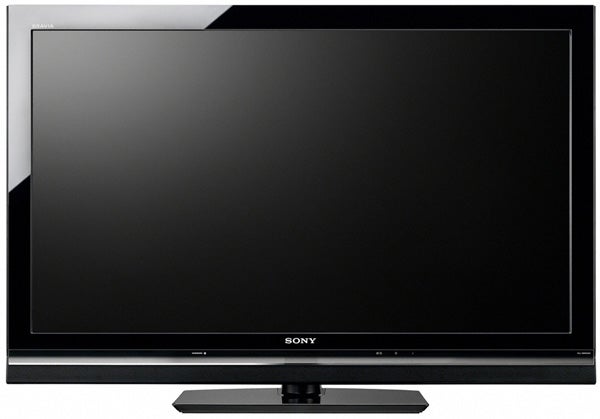
Verdict
Key Specifications
- Review Price: £1183.00
Following my review of Sony’s new KDL-40V5500 a few weeks back, in which I pointed out a troubling inconsistent backlight issue, two things happened.
First, the step-up W5500 sample I’d been expecting to receive was mysteriously delayed. And second, just a few days ago, I received a letter from Sony that first queried whether I’d set up the V5500 correctly, and second suggested that possibly the backlight problem was the result of my being sent a pre-production sample rather than a final production line unit.
My answer to the first part of this letter was that I definitely had set the TV up correctly, using the same test signals I use for every TV I test. And I’d also tried out all the TV’s various presets for good measure. But none of my efforts had been able to completely remove the backlight pooling issue.
Which leaves the assertion that possibly my pre-production test sample wasn’t working correctly. As I haven’t currently got another V5500 sat in front of me, I can’t verify whether or not Sony’s claim that the backlight pooling I saw was sample-specific, rather than generic to the V5500 range. But the letter I received also referred to a recent review of a Bravia W5500 set by a well-known print publication which docked the set an overall mark on account of – you guessed it – backlight inconsistencies. And the spectre of defective pre-production samples was raised again with regards to that sample.
So I’m pleased to say that today I can at least investigate these defective sample claims with the W5500 TV range. For the delay in my being sent a W5500 sample has turned out to be caused by Sony wanting to make sure that I got a ‘real’ sample, straight off the mass production line, rather than any more potentially flawed pre-production units. 
Normally, of course, I don’t mention ‘behind the scenes’ discussions with manufacturers in reviews. And I hope Sony doesn’t mind me referring to its recent communication here. But now that I’ve just spent some quality time with the 46in KDL-46W5500, Sony’s letter seems to be a pretty much essential piece of background information. For the bottom line is that as Sony predicted, the production-line 46W5500 suffers much less with the anticipated backlight inconsistency problem.
So if I hadn’t referred to the Sony letter, people out there who read more than one publications’ reviews of W5500 TVs might well have been confused to find some reviews saying the W5500s have a backlight problem, while others say they don’t.
Still with me so far? Hopefully so. But just in case you’re struggling, let’s slow things down a bit before getting into the key performance area by running gently through the 46W5500’s design and feature elements.
The design isn’t particularly special, in my opinion. Like the V5500 model, you’re really just talking about a glossy piano black bezel, with a little dash of style being added by a shiny strip of plastic separating the bezel from an angled-up speaker strip along the bottom edge. To be fair to Sony, though, the W5500 is, at least, very robustly built.
It’s also excellently connected. There are four HDMIs, for a start. But where the set really excels is with its multimedia support, as a D-Sub PC port is joined by a USB port capable of playing music, JPEG and video files from USB storage devices; and an Ethernet port via which you can access files stored on your PC.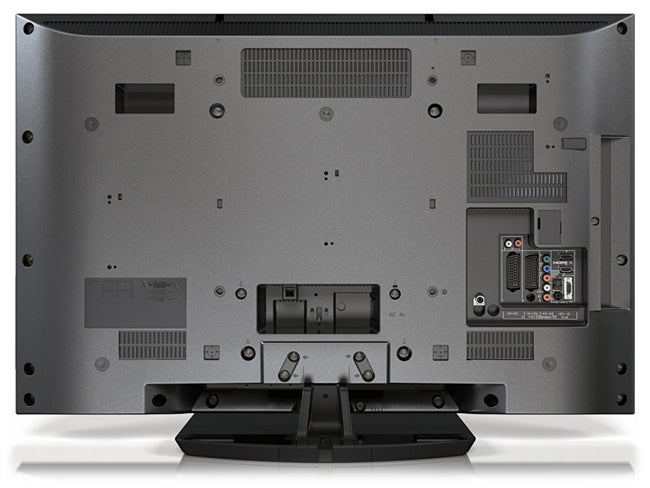
What’s more, as with the 40V5500, this Ethernet port can also give you Internet access – or rather, access to Sony’s ring-fenced online experience. As noted in the V5500 review, this so-called AppliCast system is currently rather limited, comprising just a small selection of material – a few photos, access to RSS news feeds, a World Clock and an onscreen calculator – set up by Sony’s own ‘widget’-style system. There’s no third party content on the scale of the YouTube, Yahoo, Flickr or Picasa support found on various other online TV systems right now.
The upside to the strictly controlled content of the AppliCast experience is that it helps make the system easy to use, easy on the eye, and fast and fluid in operation.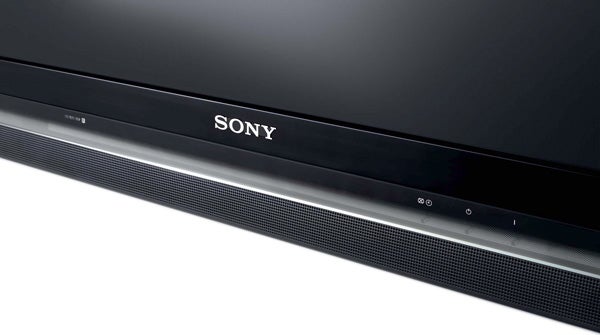
The main feature difference between the W5500 range and the V5500 range is the introduction on the W5500s of a 100Hz engine. This joins forces with Sony’s MotionFlow frame interpolation system to counter LCD’s usual problems with retaining resolution and avoiding judder when showing moving objects.
Other notable picture tricks include Sony’s 24p True Cinema mode for enhanced Blu-ray playback; Sony’s Live Colour engine designed to deliver – and I quote – ‘optimal colour purity’; the same Bravia Engine 3 video processing system that so impressed us on the 40V5500; and a variety of ‘Eco’ features, such as the increasingly common light sensor feature (which adjusts the picture in relation to the light levels in your room), and an ‘off’ timer that kicks in if the TV is left idle for a predetermined length of time. The Eco features, incidentally, are all placed under a specific Eco menu header within Sony’s mostly good double-axis onscreen menu system.
Inevitably, the 46W5500 enjoys a Full HD 1,920 x 1,080 pixel count. But rather more eye-catching is a claimed dynamic contrast ratio of 100,000:1. As ever I’m bound to point out that such figures have to be taken with a massive pinch of salt. But that doesn’t alter the fact that 100,000:1 is one of the biggest figures we’ve seen quoted for an LCD TV using standard CCFL backlight technology, and so promises impressive black levels. Especially given the big reduction in the old backlight inconsistency problem.
What’s more, the 46W5500 actually makes good on this promise, by serving up a truly excellent black level response. Dark scenes in films and games are presented, for instance, with outstandingly little trouble from the tell-tale grey clouding effect that bothers all LCD TVs to some extent. 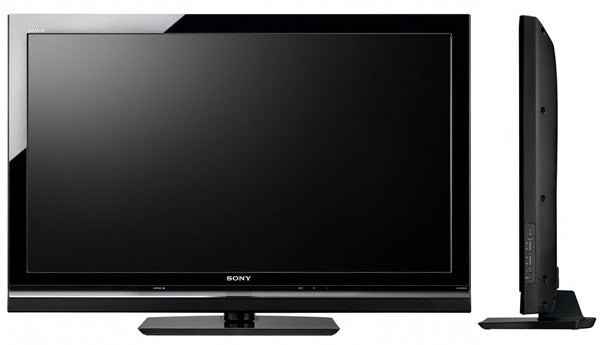
Furthermore, the dynamic contrast engine the TV employs to optimize black levels to suit your source images works extremely well, going about its business so quickly and subtly that it hardly ever distracts you from what you’re watching. Mind you, the set’s native black levels are so impressive that many of you probably won’t feel the need for the dynamic contrast engine anyway, and so can leave it turned off in return for even greater stability.
The most important thing of all about the 46W5500’s outstanding portrayal of dark scenes, though, is the fact that it delivers them without constantly leaving us distracted by the dreaded backlight inconsistencies. Even during the opening black and white sequence of ”Casino Royale” on Blu-ray, a scene that’s totally unforgiving of any backlight pooling issues a TV might have, looks almost – though still not completely, it has to be said – even in brightness from one side to the other.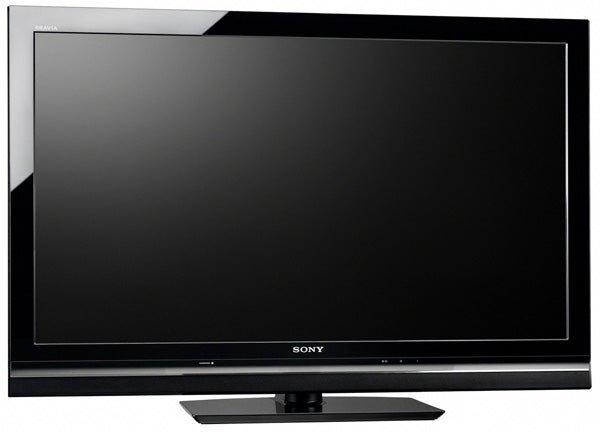
Another ace up the 46W5500’s sleeve is its response time/motion control. A particularly tough test for an LCD TV is to pan around a dark environment while playing a computer game – in today’s case, ”Dead Space” on the Xbox 360. All too often this causes an LCD screen to suffer all sorts of smeary unpleasantness and judder, yet the 46W5500 kept up with the game’s terrifying environment superbly well, keeping things sharp, smooth and clean. In doing so, it made the efforts of the Toshiba 52XV555DB I tested earlier this week look positively amateurish by comparison.
This clear motion reproduction joins forces with the 46W5500’s truly outstanding touch with HD fine detail and textures to produce one of the most consistently sharp, crisp HD pictures yet seen from an LCD TV.
What’s more, for the most part the 46W5500’s smooth, clear motion is achieved without throwing up much in the way of negative processing side effects. Yes, occasionally you can see a ring of gentle distortion around some fast-moving objects, and occasionally extremely rapid motion can flicker a touch. But the positives of the system massively outweigh the low-level, sporadic negatives – provided, at least, that you never set the Motionflow system higher than its Standard level.
Deep, natural black levels are commonly joined on TVs by a good colour response. But the 46W5500’s colours aren’t just good; they’re outstanding. Saturation levels are intense, yet never at the expense of authentic toning. The subtlety with which the TV reproduces colour blends is extreme, too, and there’s not a trace of colour noise or any sense that skin tones are having their naturalism compromised in the quest for more dramatic rich reds or blues.
In fact, the way subtle skin tones can sit right alongside extremely heavily saturated colours, such as channel logos, makes it look as if achieving such a dynamic/subtle colour combination was the easiest thing in the world. Also worth a mention is how stable and noiseless HD pictures look, and how generally intense, bright and three-dimensional pictures appear.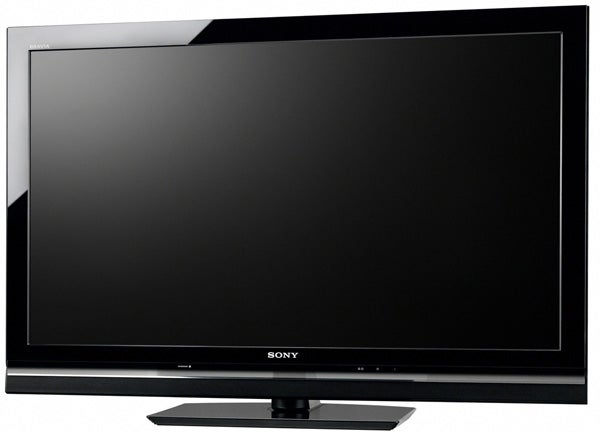
The 46W5500’s Bravia Engine 3 processing even makes it a reasonably loyal friend to standard definition too. Certainly standard definition images look sharper when upscaled to the screen’s large, Full HD resolution than they do on many rival Full HD TVs, and the extra detail is added without overly exaggerating any noise that might be tucked away inside the source broadcast/DVD. The Motionflow system works superbly with standard definition too, delivering arguably even more striking motion-boosting results than it does with HD.
Really the only complaint I might make about the set’s standard definition performance is that it seems a touch uncomfortable with skin tones, leaving them looking rather plasticky and low on detail compared with everything else in the picture.
As with the 40V5500, the 46W5500’s audio talents are good without being outstanding. Its strengths lie in its impressively well-rounded and clear presentation of vocals, even during action scenes, and the amount of treble detail it manages to inject into a movie mix without becoming harsh. A slight lack of bass extension stops it scoring higher than an eight for audio, but it’s still a good overall effort by flat TV standards.
”’Verdict”’
Given that I loved pretty much everything about the 40V5500’s performance apart from its backlight inconsistency, you probably won’t be too surprised to hear that the big reduction in this irritation for the 46W5500, together with the addition of a fine 100Hz engine, has produced a level of picture performance that truly ranks among the elite of the LCD TV world.
So however foolhardy Sony may have been in sending out flawed pre-production TV samples that clearly suffered with a problem already reported at length with previous Sony TVs, in the end there’s no denying that Sony has managed to put things right in pretty spectacular fashion.
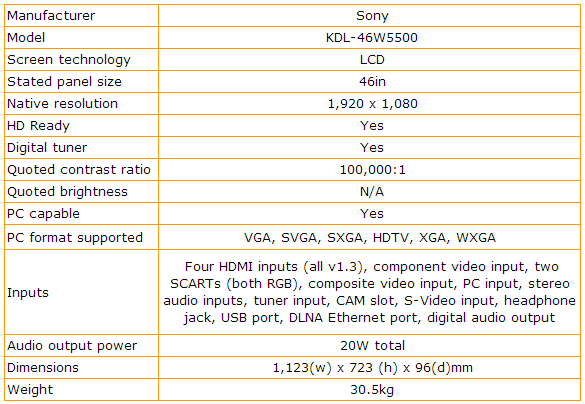
How we test televisions
We test every TV we review thoroughly over an extended period of time. We use industry standard tests to compare features properly. We’ll always tell you what we find. We never, ever, accept money to review a product.
Trusted Score
Score in detail
-
Features 9
-
Value 9
-
Image Quality 9
-
Design 7
-
Sound Quality 8
Features
| Size (Inch) | 46in |
| Display Type | LCD |

